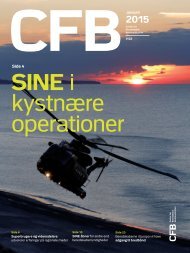CRITICAL COMMUNICATIONS CASE STUDY
6015BqJhc
6015BqJhc
Create successful ePaper yourself
Turn your PDF publications into a flip-book with our unique Google optimized e-Paper software.
INTRODUCTION<br />
FOCUS ON FINLAND AND THE FIRST USER<br />
DRIVEN COUNTRY PAVILION AT CCW<br />
Tero Pesonen, Critical Communications<br />
Broadband Group chairman, TETRA and<br />
Critical Communications Association<br />
“<br />
The world we live in is<br />
quite different - internet,<br />
mobility and globalisation<br />
are pushing operational<br />
needs.<br />
In the 90s, Finland was one of the first<br />
countries to introduce a nationwide shared<br />
TETRA network for all governmental<br />
authorities. Back then a number of user<br />
representatives such as Janne Koivukoski,<br />
Heikki Riippa and Matti Sivula to name just a<br />
few contributed strongly to the formation of<br />
TETRA standard and its capabilities to<br />
address the needs of cooperative public<br />
safety operations. Since then, field operation<br />
has continuously been developing,<br />
embracing further user groups, addressing<br />
new needs and shaking previous structures.<br />
COOPERATION IS KEY<br />
The resourcing in terms of financing as well<br />
as in manpower are limited and Finland<br />
cannot alone set course of development,<br />
which has led to the Finnish critical<br />
communications community seeking for<br />
cooperation possibilities, as well as finding<br />
ways to enhance and support mutual trust<br />
between stakeholders.<br />
Three great examples of this cooperation are:<br />
1. The Common Emergency Response Centre<br />
(ERC) provides a service to all agencies<br />
nationwide. From an administration and<br />
technical point of view, it is one entity with<br />
six physical locations.<br />
2. Police, customs and the border guard share<br />
same rights and obligations. So, they can be<br />
assigned interchangeably to missions<br />
providing great flexibility. This is particularly<br />
effective in the countryside, where units<br />
might be far apart.<br />
3. Utilities and public transport are invited<br />
to the same shared critical communications<br />
network. Ensuring energy supply is critical<br />
in modern society and the needs of railway<br />
communication can be fulfilled together<br />
with public safety as long as sufficient<br />
attention is given into details.<br />
MANAGING EXPECTATIONS<br />
Now, there is strong recognition that the world<br />
we live in is quite different – internet, mobility<br />
and globalisation are pushing operational<br />
needs. The post Google-born generation is also<br />
graduating to public safety professions with<br />
new expectations as we speak. This new era<br />
calls for re-inventing critical communication<br />
This new era calls for re-inventing critical<br />
communication. Now is the time to put joint<br />
effort in it. This is why Critical<br />
Communications Finland is now advocating<br />
seizing the moment for common good.<br />
SPOTLIGHT ON FINLAND<br />
At the Finnish Pavilion, Finnish authorities<br />
and the national public safety operator VIRVE<br />
will be sharing how Finnish safety and<br />
security agencies, social stakeholders and<br />
solution providers have made progress<br />
through co-operation and collaboration. A<br />
visitor will have a chance to learn first-hand<br />
how far Finnish critical communication<br />
users have come, as they open their way of<br />
working, sharing cooperation methods and<br />
how they addressed common challenges. An<br />
emergency services joint field commanding<br />
unit will be part of the Finnish Pavilion,<br />
demonstrating the technical solution in use.<br />
Cyber security has also been considered - from<br />
the state security smart phone usage down to<br />
the last fire fighter. The ability to build<br />
independent back-up transmission for base<br />
stations will also be addressed. But it is not only<br />
about the technology. It is also about finding<br />
solutions of how to plan and test field operations<br />
and train end users to harness the benefits.




